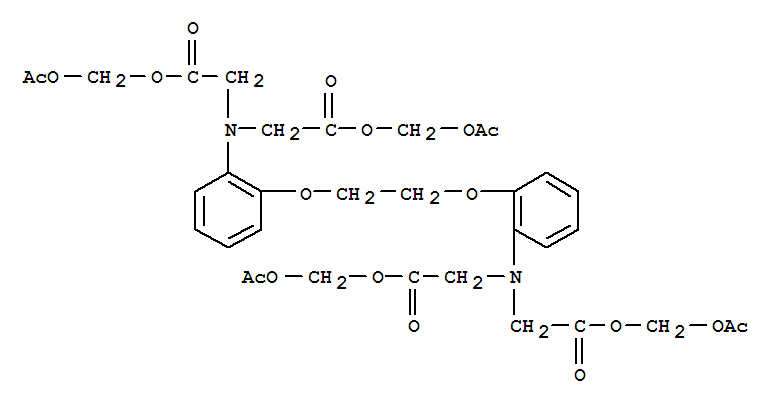| Identification |
| Name: | BAPTA-AM |
| Synonyms: | 1,2-Bis(2-aminophenoxy)ethane-N,N,N',N'-tetraaceticacidtetrakis(acetoxymethylester);Glycine,N,N'-[1,2-ethanediylbis(oxy-2,1- phenylene)]bis[N-[2-[(acetyloxy)methoxy]-2- oxoethyl]-,bis[(acetyloxy)methyl] ester; |
| CAS: | 126150-97-8 |
| Molecular Formula: | C34H40N2O18 |
| Molecular Weight: | 764.684 |
| InChI: | InChI=1/C34H40N2O18/c1-23(37)47-19-51-31(41)15-35(16-32(42)52-20-48-24(2)38)27-9-5-7-11-29(27)45-13-14-46-30-12-8-6-10-28(30)36(17-33(43)53-21-49-25(3)39)18-34(44)54-22-50-26(4)40/h5-12H,13-22H2,1-4H3 |
| Molecular Structure: |
 |
| Properties |
| Density: | 1.35 g/cm3 |
| Refractive index: | 1.551 |
| Appearance: | white powder or crystalline powder |
| Specification: |
BAPTA-AM ,its cas register number is 126150-97-8. BAPTA-AM (CAS NO.126150-97-8) also can be called 1,2-Bis(2-aminophenoxy)ethane-N,N,N',N'-tetraacetic acid, tetraacetoxymethyl ester .
|
| Biological Activity: | Selective calcium chelator that is the cell-permeable analog of BAPTA (Cat No. 2786 ). Blocks hK v 1.5, hERG and hK v 1.3 channels (K i values are 1.23, 1.30 and 1.45 μ M respectively). Displays antithrombotic activity in vitro . |
| Storage Temperature: | −20°C |
| Usage: |
BAPTA-AM (CAS NO.126150-97-8) is a cell permeable derivative of BAPTA which is widely used as an intracellular calcium sponge. Fluorescence: max. Abs. 287nm; e x 10-3: 5.9.
|
| Safety Data |
| Hazard Symbols |
 Xi: Irritant
Xi: Irritant
|
| |
 |